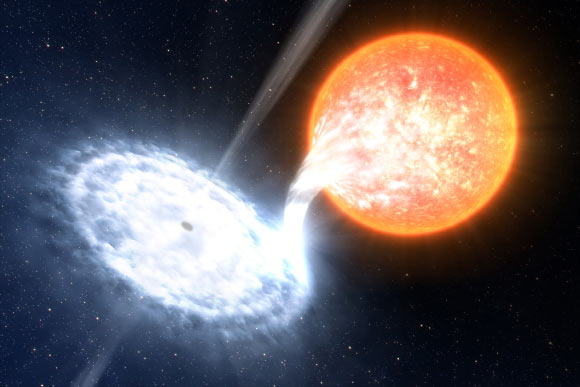Astronomers have detected gamma rays coming from the outermost regions of an unusual star system within our Milky Way Galaxy. The source is a microquasar — a black hole that gobbles up stuff from a nearby companion star and blasts out two powerful jets of material. The observations suggest that electron acceleration and collisions at the ends of the microquasar’s jets produced the powerful gamma rays.

SS 433 is a microquasar located in the constellation Aquila, some 15,000 light-years from Earth. Image credit: L. Calçada / ESO.
Quasars are massive black holes that suck in material from the centers of galaxies, rather than feeding on a single star. They actively emit radiation visible across the Universe.
But most are so far away that the majority of the detected quasars must have their jets aimed at Earth, making them easier to spot, like looking directly into a flashlight.
In contrast, jets from a small-scale version of quasar called SS 433 are oriented away from Earth, which makes them more difficult to observe.
“Our findings improve understanding of particle acceleration in jets of microquasars, which also sheds light on jet physics in much larger and more powerful extragalactic jets in quasars,” said co-lead author Dr. Hao Zhou, a researcher in the Physics and Theoretical Divisions at Los Alamos National Laboratory.
Dr. Zhou and colleagues gathered data from the High-Altitude Water Cherenkov Gamma-Ray Observatory (HAWC), which is a mountain-top detector in Mexico that observes gamma ray emission from supernova remnants, rotating dense stars called pulsars, and quasars.
They examined the HAWC data taken from more than 1,017 days of the SS 433 observation and saw evidence that gamma rays were coming from the ends of the microquasar’s jets, rather than the central part of the star system.
Based on their analysis, the astronomers concluded that electrons in the jets attain energies that are about 1,000 times higher than can be achieved using Earth-bound particle accelerators, such as the Large Hadron Collider.
The jet electrons collide with the low-energy microwave background radiation that permeates space, resulting in gamma ray emission.
This is a newly observed mechanism for getting high-energy gamma rays out of this kind of system and is different from what scientists have observed when the jets are aimed at Earth.
“What’s amazing about this discovery is that all current particle acceleration theories have difficulties explaining the observations,” said co-author Dr. Hui Li, a theorist in Los Alamos National Laboratory’s Theoretical Division.
“This surely calls for new ideas on particle acceleration in microquasars and black hole systems in general.”
The findings were published in the October 4, 2018 issue of the journal Nature.
_____
A.U. Abeysekara et al. 2018. Very-high-energy particle acceleration powered by the jets of the microquasar SS 433. Nature 562: 82-85; doi: 10.1038/s41586-018-0565-5







